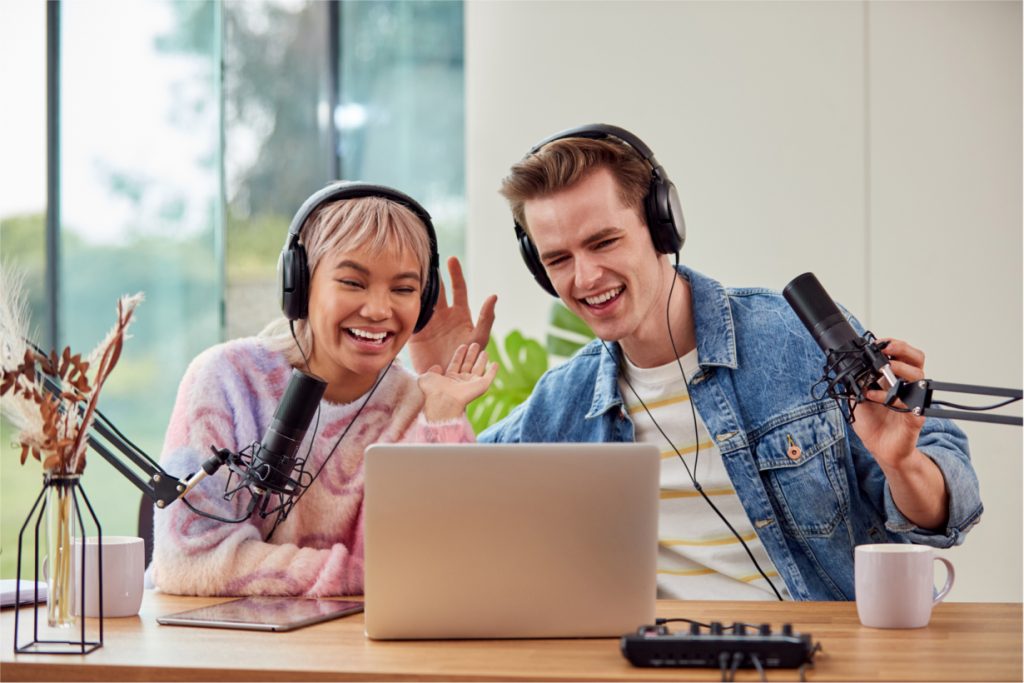Online content was made to be monetized, whether you profit from it or the platform does. Countless YouTubers have made millions not just by hosting podcasts, promoting toys, and playing video games but also by knowing how to maximize monetization at every turn.
Building a layered content monetization strategy is crucial to increasing your online revenue, whether you're pivoting to digital content or turning a hobby into a career. Simply having one goal, such as ad monetization, isn't always enough to secure income. Sponsorships, subscriptions, merchandise, and other monetization tools will make your revenue more well-rounded and prepared for the inevitable changes in content creation.
In this blog, we'll discuss ideas for monetizing digital content, including branding, becoming an affiliate, and expanding to popular platforms.
What Is Content Monetization?
Content monetization describes almost any type of revenue that comes from the viewership or consumption of your content. This can comprise direct monetization, such as income from ads and subscriptions, or indirect instances, such as viewers inspired to purchase merchandise.
Knowing how to monetize content is a key aspect of content creation, ensuring you have multiple ways to profit from your projects. Fortunately, there are a plethora of monetization options available for digital content, especially as you branch out to different popular platforms.
8 Ways To Monetize Content as a Content Creator
Even if you didn't initially consider your original content profitable, you may be surprised by the various ways you could monetize it. Below are some of the best strategies for how to do so.
Enable Platforms Advertising
Many platforms already feature ad monetization, which usually only becomes usable after your social media channels or profiles meet certain requirements, such as a certain number of streams. For example, YouTube requires you to have at least 1,000 subscribers and 4,000 watch hours in one year to apply for their Partner Program. Additionally, most platforms mandate that your content and music must be royalty-free to be monetized.
One drawback of platform-enabled advertising is that your monetized content must fall within certain restrictions. This can sometimes create issues, including for video game YouTubers struggling to meet ad parameters for M-rated games. These content creators must often look to sponsorships and other monetization options instead.

Partner With Companies for Sponsorships
Finding sponsors can be simple, or it can be complicated, depending on your content, platform, and goals. Sponsored content can take nearly any form, from a short blip about Raid: Shadow Legends to a free product highlighted in your video.
Many content platforms, such as Twitch and TikTok, offer options to connect with sponsors through their systems. For other platforms and specific niches, however, you may need to reach out to sponsors yourself through email, LinkedIn, or your potential sponsor's website.
TikTok recently introduced a unique monetization feature called the "TikTok Creative Challenge" that lets content creators submit video ads to sponsors. If advertising companies use their videos, creators receive revenue based on the video's overall performance. This is just another new and easy way for content creators to start working with sponsors without enduring the entire networking process.
Include Affiliate Links in Your Social Media Platforms
Affiliate links are a useful way to partner with sponsors and increase revenue from your audience. Affiliate links are custom-coded to keep track of how many people visit a certain product page via your content. Both you and the sponsor can monitor how many people purchased the product based on your promotion, allowing you to receive a commission based on sales rather than views.
Another benefit of affiliate marketing is that you don't always need entire videos or blog posts to highlight links. You can include them in social media posts, such as your Instagram story. You can also share affiliate links as many times as you want, such as in the description of every YouTube video that uses the product.
Offer Memberships for Exclusive Content
The most loyal members of your audience who genuinely enjoy your content can provide you with a consistent income. Patreon and other platforms allow you to share exclusive content with subscribers for a monthly or annual fee. While these subscription services shouldn't be your only form of social media monetization, they're beneficial for establishing a minimal income each month. Even if your videos get zero views, you'll always have your subscribers.
The "exclusive content" you share through memberships doesn't need to be extraordinary, but it should be special enough to keep fans interested. Examples include:
- Content not posted anywhere else
- Access to content before it releases
- Custom merchandise
- Behind-the-scenes content, such as a "making of" video
- Personalized videos and content
- Credit at the end of longer videos
- Unique interactions between subscribers and creators
Develop Merchandise With Your Brand
Many YouTubers begin and end their videos by plugging their merch shop, often featuring hoodies, shirts, and memorabilia. Depending on your niche and fanbase, merchandise can be a fantastic and direct way to secure income. The content you sell can include clothing, useful products, original creations, and more. Selling products with your logo and establishing an online store can also help you expand your brand.
Many content creators use social media polls and exclusive content platforms to gauge interest when brainstorming products. And fortunately, it's possible to sell merch without worrying about supply costs thanks to drop-shipping, a service that lets you sell custom products without stocking them.
Promote Online Courses
The internet is full of stories about teachers quitting to tutor on YouTube and skilled TikTokers making it big with just a few videos. Many viewers may already look to you as an expert, so depending on your content topic, expanding to online courses could be easier than you think.
Platforms like MasterClass and Skillshare allow content creators to learn one other's crafts and professional skills. Combined with tutorials on your other platforms, this extra content could provide a more well-rounded monetization strategy. You can also create your own platform and website containing all of your tutoring content in one place, ensuring you always hold exclusive rights.
Join Affiliate Programs Related to Your Target Audience
A company's affiliate program works with affiliate content creators, supplying them with products, links, sponsorships, and other monetization options. When looking for companies to partner with, consider the products and services related to your channel's niche and audience.
For example, if you run a yoga channel, start with yoga accessories, including mats, blocks, and pants. Then, consider the products and services related to yoga, such as meditation apps, non-slip socks, diffusers, or anything unique to your channel and audience.
Look at the affiliate programs similar content creators have partnered with and begin reaching out to companies. As you expand your audience and brand, more affiliate programs may be interested in partnering with you.
Offer Public Speaking Engagements or Workshops
While engaging within blogs and comment sections gives your channel a more personal touch, nothing beats in-person interaction. Hosting in-person workshops and engagements is a fantastic way to further monetize your channel and expand your brand. It can transform passive fans into active fans and let people interested in your topic get to know you and your content.
Depending on your niche, you may be able to include your workshops and speaking opportunities within larger events. Search for conventions, competitions, local events, and other engagements that fit your audience. Alternatively, consider venues where you can host your own events, such as restaurants, community centers, or related businesses.
As you decide how to engage with your community, consider what events work best for your content and monetization strategy. For example, if you produce podcasts, consider hosting public recording sessions or fan club meetings.
Create High-Quality Content With Royalty-Free Music
An essential aspect of monetization is the effort and attention to detail you put into your projects. Sponsors, affiliate programs, and viewers will be more attracted to your channel if you produce consistently high-quality content. When learning how to monetize video content, this includes supercharging your video and audio quality.
Royalty-free music keeps you legally protected when producing original content, especially when trying to monetize it. While using non-licensed music is sometimes passable online, perhaps for personal projects and blog posts, it becomes a problem if you profit from it. Using non-royalty-free audio in your YouTube video could get it removed or change your monetization so the rights holder gets paid for your views.
Whether you're learning how to monetize content on Instagram, YouTube, or another platform, you should have access to a vast inventory of stock music to improve your videos. This way, you can use nearly any type of audio, from soft background to exciting sound effects, without worrying about losing your monetization. Check out our royalty-free audio library and learn how to get unlimited access today.




